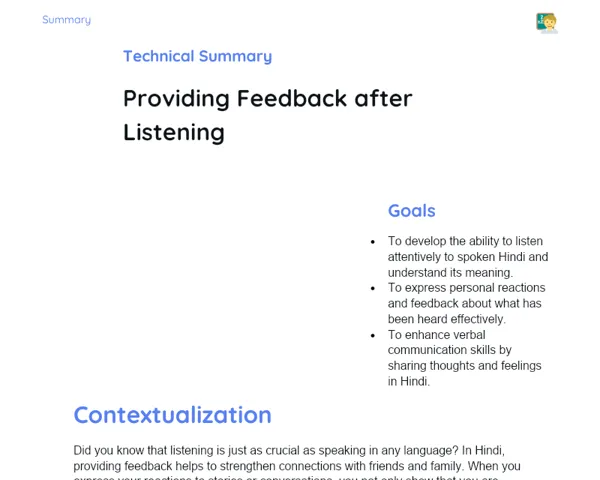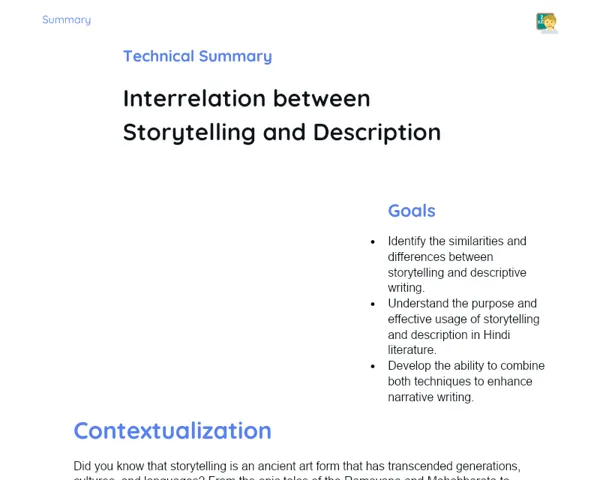## Goals
1. To develop the ability to listen attentively to spoken Hindi and understand its meaning.
2. To express personal reactions and feedback about what has been heard effectively.
3. To enhance verbal communication skills by sharing thoughts and feelings in Hindi.
Contextualization
Did you know that listening is just as crucial as speaking in any language? In Hindi, providing feedback helps to strengthen connections with friends and family. When you express your reactions to stories or conversations, you not only show that you are engaged but also help others understand how their words resonate with you. It’s like adding a splash of colour to your conversations—making them lively and meaningful!
Subject Relevance
To Remember!
Active Listening
Active listening is the skill of fully concentrating, understanding, responding, and remembering what is being said. It goes beyond merely hearing the words; it involves engaging with the speaker through verbal and non-verbal feedback, such as nodding or using affirmations like 'Wow!' or 'Really?'. By applying active listening, you not only grasp the content better but also show respect and empathy towards the speaker, helping to create a warm and open environment for communication.
-
Enhances Understanding: Active listening improves your comprehension of the message being conveyed, allowing you to respond more thoughtfully.
-
Builds Trust: Engaging attentively shows the speaker that their thoughts are valued, fostering deeper connections in relationships.
-
Promotes Empathy: By actively listening, you can better understand the speaker's feelings and perspectives, which is essential for effective communication in Hindi.
Expressing Feedback
Once you’ve actively listened, the next step is expressing your feedback. This involves sharing your thoughts and feelings about what you heard. Feedback can be positive, negative, or neutral, but it’s important to be honest and respectful. In Hindi conversations, expressing feedback not only demonstrates understanding but also encourages dialogue and helps clarify any misunderstandings. For example, saying 'That story made me feel happy!' enriches the conversation and invites the speaker to share more.
-
Encourages Dialogue: Providing feedback opens the floor for further discussion, making conversations in Hindi more interactive and engaging.
-
Clarifies Understanding: Sharing your feedback helps ensure that you understood the message as intended, allowing the speaker to refine or elaborate on their points.
-
Fosters Respectful Communication: When feedback is given carefully, it contributes to a respectful exchange, essential for healthy relationships.
Using Non-Verbal Cues
Non-verbal cues, such as facial expressions, hand gestures, and body language, play a crucial role in how feedback is perceived. They can reinforce your verbal messages or convey emotions that words sometimes can't express. For instance, smiling when someone shares a joyful moment helps convey shared happiness. In Hindi, acknowledging emotions through non-verbal communication makes interactions more genuine and heartfelt.
-
Enhances Emotional Connection: Non-verbal cues strengthen the emotional bond between speakers, emphasizing feelings in a conversation.
-
Supports Verbal Communication: They act as a supportive tool to clarify the speaker's message, making your feedback more meaningful.
-
Creates a Positive Atmosphere: Using appropriate gestures and expressions can uplift the mood of a conversation, encouraging more open sharing.
Practical Applications
-
During family gatherings, practice active listening with your relatives. Ask follow-up questions about their stories and express your thoughts on them to enhance the connection.
-
In school, pair up with a friend to share a short story or experience. After sharing, give each other feedback using both verbal and non-verbal cues to improve your communication skills.
-
Watch a Hindi movie and discuss it with your family or friends. Use this opportunity to express your reactions and practice giving feedback on the characters' actions or the storyline.
Key Terms
-
Active Listening: The skill of being fully present and engaged in a conversation, ensuring that you understand the speaker’s words and emotions.
-
Feedback: The response given to someone after they have shared information or a story, aimed at fostering further discussion and understanding.
-
Non-Verbal Cues: The gestures, facial expressions, and body language that accompany verbal communication, essential for conveying feelings and emotions.
Questions for Reflections
-
Why do you think actively listening to someone is important? How can it change the way we communicate in Hindi?
-
Reflect on a time when you received feedback that made you feel valued. How did that impact your relationship with the speaker?
-
Consider how non-verbal cues can alter the meaning of spoken words. Can you think of an example where this happened in your life?
The Feedback Relay Challenge!
In this challenge, you will team up with a family member or friend to practice your listening and feedback skills. Start by sharing a short story about something exciting that happened to you recently. After you share, your partner will provide feedback using both verbal and non-verbal cues. Then, switch roles! This relay of sharing and feedback will help you understand how much words and emotions matter in communication.
Instructions
-
Choose a partner (a friend or family member).
-
Take turns sharing a story of around 2-3 minutes.
-
After one person shares, the listener should provide feedback both verbally (comments about the story) and non-verbally (smiling, nodding, etc.).
-
Switch roles and repeat the process until both have shared and received feedback.
-
Discuss what felt good about the feedback you received and how it made your conversations richer.



